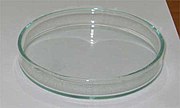Only two more days for the Classic Papers Challenge, so if I’m going to get any more up, I’d better get my butt in gear.
Here’s a nice easy one:
The American Society for Microbiology has a translation available online. It’s only about a page-and-a-half of relatively large type – check it out.
There’s a trick we microbiologists use for growing bacteria. You make a solid (but wet) surface that contains whatever nutrients the microbe (bacteria, archaea, yeasts, mold spores…) you’re interested in need, and then you spread a diluted mixture of the microbe on it. The idea is that since the surface is solid the microbes can’t move around too much, and at any spot where a single cell starts initially, a whole pile of that cell and it’s genetically-identical (non-sexually-produced) clone-children will form until it gets big enough to see without a microscope. This cell-pile is called a “colony”, and you can poke or rub it with a sterile object, then stick the object into a sterile nutrient source. The end result is you have a “pure” culture of microbes that are effectively genetically identical. The solid material could be a lot of things – I’ve seen references to using slices of potato – though these days agar-agar gel mixed with nutrients is the preferred substance.
Koch (that is, Robert Koch of “Koch’s Postulates” fame, not Ed Koch the former mayor of New York City) used gelatin (so, hey, here’s another thing you can do with your expired Jell-O®). He apparently used to have a stack of shallow bowls, and had to use a special pouring device to carefully dump the gelatin into each stacked bowl in turn, then cover the works with a bell jar in order to keep stuff from falling into them from the air and contaminating them.
This was kind of a pain to work with, so some clever guy named Julius came up with a modification of this method in 1887, using pairs of shallow dishes, one slightly larger than the other so that it could be turned upside down to use as a lid. Then, you don’t necessarily need the bell jar, and you don’t need to stack them so they’re easier to pour.
 Julius Robert Petri’s idea was so useful that we still use it today. Oh, yeah, and they named the dish-and-lid combination after him.
Julius Robert Petri’s idea was so useful that we still use it today. Oh, yeah, and they named the dish-and-lid combination after him.
How’s that for a “classic” paper?
Meanwhile, my “Mountain Dew® Wine” project is turning out to be substantially more educational and fascinating than I’d hoped. There seems to be a decent amount of information available on how benzoic acid affects yeasts. I intend to turn that into a post later, but first I’ll try to find at least one more old paper to post before tomorrow is over…